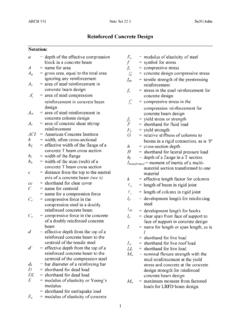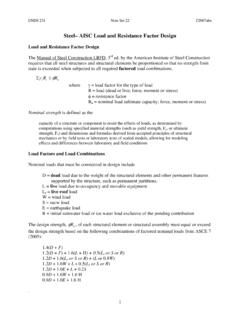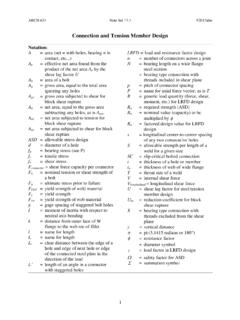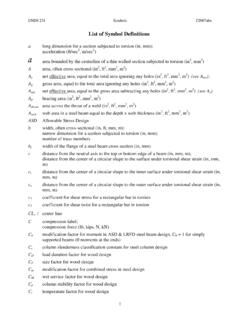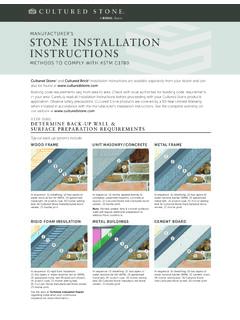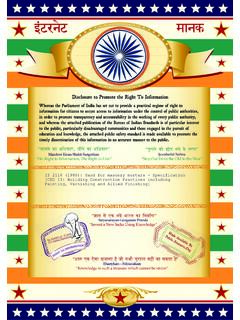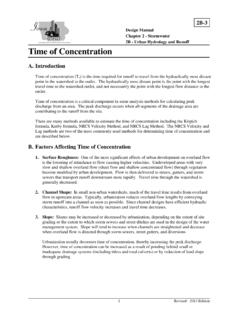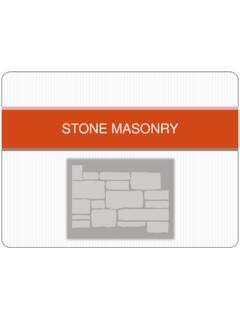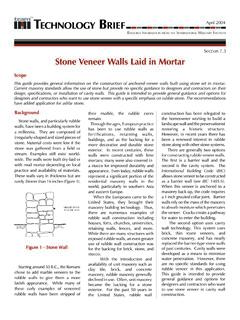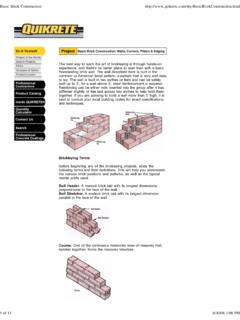Transcription of Masonry Design - Texas A&M University
1 ARCH 331 Note Set Su2014abn 1 Masonry Design Notation: A = name for area An = net area, equal to the gross area subtracting any reinforcement Anv = net shear area of Masonry As = area of steel reinforcement in Masonry Design Ast = area of steel reinforcement in Masonry column Design ACI = American Concrete Institute ASCE = American Society of Civil Engineers b = width, often cross-sectional C = name for a compression force Cm = compression force in the Masonry for Masonry Design CMU = shorthand for concrete Masonry unit d = effective depth from the top of a reinforced Masonry beam to the centroid of the tensile steel e = eccentric distance of application of a force (P)
2 From the centroid of a cross section fa = axial stress fb = bending stress mf = calculated compressive stress in Masonry mf = Masonry Design compressive stress sf = stress in the steel reinforcement for Masonry Design fv = shear stress Fa = allowable axial stress Fb = allowable bending stress Fs = allowable tensile stress in reinforcement for Masonry Design Ft = allowable tensile stress Fv = allowable shear stress Fvm = allowable shear stress of the Masonry Fvs = allowable shear stress of the shear reinforcement h = name for height = effective height of a wall or column Ix = moment of inertia with respect to an x-axis j = multiplier by effective depth of Masonry section for moment arm, jd k = multiplier by effective depth of Masonry section for neutral axis.
3 Kd L = name for length or span length M = internal bending moment = type of Masonry mortar Mm = moment capacity of a reinforced Masonry beam governed by steel stress Ms = moment capacity of a reinforced Masonry beam governed by Masonry stress MSJC = Masonry Structural Joint Council n = modulus of elasticity transformation coefficient for steel to Masonry = shorthand for neutral axis ( ) N = type of Masonry mortar NCMA = National Concrete Masonry Association O = type of Masonry mortar P = name for axial force vector Pa = allowable axial load in columns r = radius of gyration S = section modulus = type of Masonry mortar Sx = section modulus with respect to an x-axis t = name for thickness T = name for a tension force Ts = tension force in the steel reinforcement for Masonry Design TMS = The Masonry Society w = name for distributed load 1 = coefficient for determining
4 Stress block height, c, in Masonry LRFD Design m = strain in the Masonry s = strain in the steel = reinforcement ratio in Masonry Design ARCH 331 Note Set Su2014abn 2 Reinforced Masonry Design Structural Design standards for reinforced Masonry are established by the Masonry Standards Joint Committee consisting of ACI, ASCE and The Masonry Society (TMS), and presents allowable stress Design as well as limit state (strength) Design . Materials f m = Masonry prism compressive strength from testing Reinforcing steel grades are the same as those used for reinforced concrete beams.
5 Units can be brick, concrete or stone. Mortar consists of Masonry cement, lime, sand, and water. Grades are named from the word MASONWORK, with average strengths of 2500psi, 1800 psi, 750 psi, 350 psi, and 75 psi, respectively. Grout is a flowable mortar, usually with a high amount of water to cement material. It is used to fill voids and bond reinforcement. Clay and concrete Masonry units are porous, and their durability with respect to weathering is an important consideration. The amount of water in the mortar is important as well as the absorption capacity of the units for good bond; both for strength and for weatherproofing.
6 Because of the moisture and tendency for shrinkage and swelling, it is critical to provide control joints for expansion and contraction. Sizes Common sizes for clay brick and concrete Masonry units (CMU) are shown in the figure, along with definitions. Typical section properties for CMU s are provided for reference at the end of the document. Allowable Stress Design For unreinforced Masonry , like Masonry walls, tension stresses are allowed in flexure. Masonry walls typically see compression stresses too.
7 Standard Modular Clay Brick 4 in. Normal Clay Brick Two Core Stretch Unit Three Core Stretch Unit ARCH 331 Note Set Su2014abn 3 b For reinforced Masonry , the steel is presumed to resist all tensile stresses and the tension in the Masonry is ignored. Factors of Safety are applied to the limit stresses for allowable stress values: bending (unreinforced) Fb = 1/3mf bending (reinforced) Fb = bending (tension/unreinforced) table beam shear (unreinforced for flexure) Fv = 120 psi beam shear (reinforced) M/(Vd) Fv = beam shear (reinforced) M/(Vd) Fv = Grades 40 or 50 reinforcement Fs = 20 ksi Grades 60 reinforcement Fs = 32 ksi Wire joint reinforcement Fs = 30 ksi where f m = specified compressive strength of Masonry Internal Equilibrium for Bending Cm = compression in Masonry = stress x area = 2)
8 (kdbfm Ts = tension in steel = stress x area = Asfs Cm = Ts and Mm = Ts(d-kd/3) = Ts(jd) Ms =Cm(jd) where fm = compressive stress in the Masonry from flexure fs = tensile stress in the steel reinforcement kd = the height to the neutral axis b = width of stress area d = effective depth of section = depth to of reinforcement jd = moment arm from tension force to compression force As = area of steel n = Es/Em used to transform steel to equivalent area of Masonry for elastic stresses = reinforcement ratio BIA Teknote 17 seriesgrout unit t sTs=A s f sfs/n mCm=fmb(kd))
9 /2jd bdAs= M2kdbffAmss= F=0: ARCH 331 Note Set Su2014abn 4 Criteria for Beam Design For flexure Design : or ssssjf bdjdfAM2== The Design is adequate when bbFf in the Masonry and ssFf .in the steel. Shear stress is determined by fv = V/Anv where Anv is net shear area. Shear strength is determined from the shear capacity of the Masonry and the stirrups: Fv = Fvm + Fvs. Stirrup spacings are limited to d/2 but not to exceed 48 in. where: + = where M/(Vd) is positive and cannot exceed = Load and Resistance Factor Design The Design methodology is similar to reinforced concrete ultimate strength Design .
10 It is useful with high shear values and for seismic Design . The limiting Masonry strength is m. Criteria for Column Design ( Masonry Joint Code Committee) Building Code Requirements and Commentary for Masonry Structures define a column as having b/t < 3 and h/t > 4. where b = width of the wall t = thickness of the wall h = height of the wall A slender column has a minimum dimension of 8 on one side and h/t 25. Columns must be reinforced, and have ties. A minimum eccentricity (causing bending) of times the side dimension is required.



